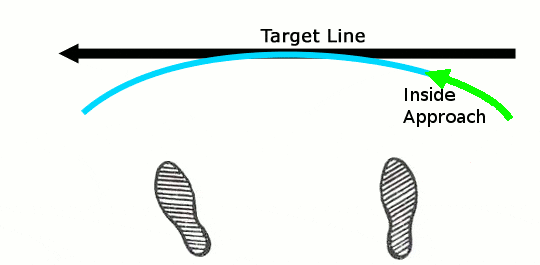 Swing path is often confused with swing plane, but there's a subtle difference.
Swing path is often confused with swing plane, but there's a subtle difference.
The plane of the golf swing is the angle (relative to the ground) on which the shaft travels around the body. Swing path is the route the clubhead follows during the swing.
Every golfer's swing path falls into one of three categories, all relative to the target line: square, inside-out, and outside-in (also called over-the-top). The path of the clubhead typically determines the direction in which a shot will start. For example, a club traveling from inside-to-outside the line will start the ball right of target (right-handed golfers).
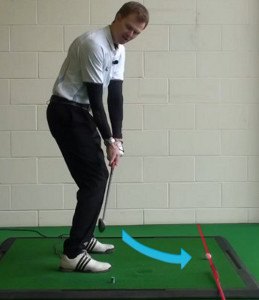
While a square path would seem ideal, pros' swings are marked by a very slight inside-out route. Coupled with a clubface that's square to the target line, this creates a trapping action at impact that compresses the ball and generates extra distance. The inside-out path is necessary to hit a draw, too.
To check your swing path with an iron:
- Place a club on the ground, behind the ball, pointed directly at your target.
- Use the aiming club to align your clubface with the target, then make a normal swing producing a divot.
- Check the divot's direction against the aiming club. If the divot points left, your path is outside-in, and vice versa.
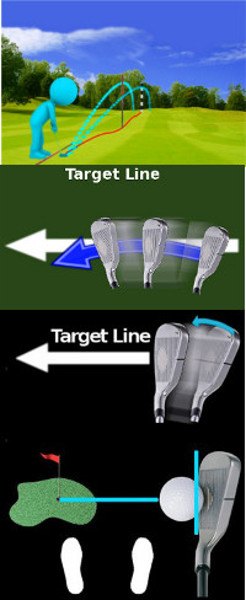
What is the Golf Swing Path?
Golf is a game that could have a dictionary all to itself. While the game might seem simple at first blush – get the ball into the hole in as few strokes as possible – it is actually rather complicated. As you gain experience in the game of golf, you will learn more and more about the small details that make up the swing, the rules, course design, and more. One of the things that has helped golf become so incredibly popular is the fact that it can never be completely understood or mastered. No matter how good you are or how much golf you have played, there will always be more to learn.
One of the terms that you will need to learn as you are working on improving your swing and your game as a whole is 'golf swing path'. Most likely, you have already heard this term at least a time or two when watching golf or TV or listening to other people talk about their swings on the range. Swing path is an important concept in the golf swing, as the path that you use through the hitting area is largely responsible for determining the path of the shot. Without control over your swing path, you will always struggle to gain control over your golf ball.
This article will go on to explain what exactly is meant by the term 'golf swing path', and how it can help you play better golf. However, before getting into those details, it is important that you understand how to keep the technical side of golf in perspective. There is a fine line between improving your game by learning technical details and damaging your game by losing your natural athletic motion. A golf swing that is too technical will actually be worse than one which ignores the conventional mechanics altogether. You always want to feel free and relaxed over the ball, and those feelings will be impossible to find if you are stressing about every small detail within your swing. Educate yourself on the finer points of the swing and work on those points on the driving range, but do your best to leave those thoughts behind when you hit the first tee.
There is one other reason why it will be beneficial to you to learn some of the basic terms and expressions associated with the golf swing. If you should decide to take golf lessons at some point in the future, understanding golf 'lingo' will help you to get the maximum benefit from those lessons. Even the best golf teacher may have trouble explaining their advice without the use of some common golf terms, so you will be better served if you can 'speak the language' prior to taking a lesson. You don't need to be an expert in golf terminology in order to benefit from a lesson or two, but it will help to be familiar with the basics.
All of the instruction contained below is based on a right handed golfer. If you play left handed, please take a moment to reverse the directions as necessary.
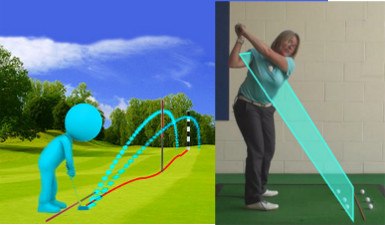
A Definition
Generally speaking, it is the path of the club head through the hitting area that is being referred to when golfers speak of the golf swing path. Of course, it is possible that some golfers will use this term to refer to the path of the club throughout the entire swing, but most people use it only in reference to the way the club moves through the hitting area. As the club head whips through the ball at the bottom of the swing, picture it making a line that runs from about a foot behind the ball to a foot in front of the ball. That line is your golf swing path. The direction of that path will play a major role in the outcome of your shots.
It should be said that there isn't necessarily a 'perfect' swing path that you can use for every shot that you hit. The right swing path for a given shot depends on the club that you are hitting, the ball flight you are trying to create, and more. Swing path will vary from golfer to golfer, even among the best players in the world. As long as your swing path isn't way out of line, you should be able to hit good shots using a variety of different angles to attack the ball.
While there isn't one path which is considered 'right', you will want to work on your ability to repeat the same path over and over again. Consistency is like gold on the golf course – if you can produce the same ball flight time after time, you will be able to shoot good scores. One of the key ingredients to consistency is the ability to move the club through the hitting are in the same direction time after time, all day long. Many golfers struggle with this aspect of the game, and their ball flight is far from consistent as a result. A consistent swing path is the result of repeatable and simple swing mechanics, so working on the basics of your swing will go a long way toward helping you gain control over your ball.
When talking about the swing path, you will likely hear a couple of different expressions – inside-out, and outside-in. These two expressions are opposites, and they describe the way the club is moving through the hitting area. If you are using an inside-out swing path, you are moving the club farther away from your body as it goes through the ball. The club is coming down toward impact relatively close to your body, and it is moving away from you at impact. This is the kind of swing path that will generally produce a draw or a hook, depending on the angle of the face when you contact the ball.
As you might suspect, an outside-in swing path is one that sees the club head getting closer to your body as it comes through the ball. You start the downswing with the club pushed out away from your body, and you gradually bring the club back in closer to you as the swing progresses. This is the swing path associated with hitting a fade or a slice, again depending on the face angle at impact. Golfers who struggle with a slice on a regular basis likely have a dramatic outside-in swing path at the bottom of the swing.
Since it is nearly impossible to move the club straight down the line throughout the hitting area, most golfers will fall into one of these two categories (outside-in or inside-out). It is certainly possible to play good golf with either option, so you don't need to feel compelled to switch from one to the other. However, it is important that you know which path you are using so you can tailor the rest of your swing to match that style.
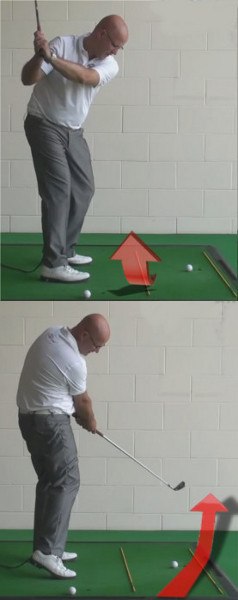
The Connection Between Swing Path and Face Angle
It is basically impossible to cover the topic of swing path without getting into the importance of face angle. These two topics will forever be linked in the game of golf, and you probably have noticed that face angle was already mentioned a couple of times earlier in this article. Swing path and face angle are the two main determining factors of where your ball is going to end up, so understanding each of these points is crucial.
Face angle refers to the direction the face of the club is pointing when it contacts the ball. A perfectly square face angle would be perpendicular to the swing path, meaning the ball should fly straight in the direction that your swing is moving. Of course, the word 'perfect' is rarely used in the game of golf, and it is nearly certainly that your face angle will be pointed at least a little bit to the right or left of your swing path at impact. Therefore, you should expect every shot that you hit on the course to have some degree of curve as it travels through the air. The ability to control that curve, and predict it from shot to shot, is what separates the average players from the good ones.
When you are analyzing the position of your face angle at impact, you will always be referring to it in comparison to your swing path. The imaginary line that your swing path makes through the hitting area is the reference point, and from that you can then determine if the face is open or closed at impact. If the face of the club is pointing to the right of the swing path line, you are in an open position. If you find that the club face is pointed to the left of the swing path, the club is closed or 'shut'. An open club face will produce a ball flight that curves from left to right, while a closed club face will create a right to left trajectory.
Understanding these basics of the golf swing is a big help when trying to figure out why the ball is curving in one direction or the other. Many golfers simply look at the ball in bewilderment as it flies through the air, unsure of what caused it to either move to the right or the left. Now that you understand the importance of the relationship between face angle and swing path, there will be no doubt in your mind as to what sent your ball in a specific direction. While there will still be work that has to be done in order to correct any swing problems that you are dealing with, at least you will know the root cause of the issue. Knowledge is power in golf, and you know should have a better understanding of what swing path and face angle do to your golf ball.
As this article is focused on the topic of swing path, we aren't going to get too far into the details behind controlling the face angle. However, one point that you should keep in mind is that the position of your club face is directly tied to your grip on the club. Once you set the grip at address, you claim control over the angle of the club face until the swing is finished. If you can get your hands back into the same position that they were in at address, you should have the face is a relatively square position. Making excessive movements with your hands and wrists during the swing will only cause you to lose track of the club face position, so keep everything as quiet as possible while using your body to swing the club back and through.

Short Game Swing Path
Swing path is usually referenced in the context of the full swing, but it is just as important in the short game. Using a good swing path in your short game – which includes putting, chipping, and pitching – is crucial to saving strokes on and around the greens. While most golfers spend the majority of their time working on the full swing, it is actually your short game that will have the most to say about your success or failure on the course. If you are serious about shooting good scores on a regular basis, the short game is where you will spend most of your time.
The nice thing about topics like swing path and face angle in the short game is that they are easier to understand because you don't need to worry about sidespin. The ball isn't going to curve in the air when you are chipping or pitching from short range, so things like hooks and slices are out of the equation. Also, any changes you make to your swing path in the short game will be easier to implement because the club is moving at a low rate of speed as compared to when you are hitting full shots.
With all of that said, you still need to focus on using a good swing path and a square club face if you would like to hit quality short game shots. For the most part, the swing path that you use in the short game is going to follow along the path of your stance. So, if you stand square to the target, you should be able to execute a swing path that draws a straight line toward the hole. If you stand open, such as when you are chipping, your path will move to the left. Depending on the type of shot you want to hit, you can adjust your stance, and your swing path as a result.
For example, if you would like to hit a 'standard' chip shot from the side of the green, you would stand with your feet just slightly open to the target to encourage an outside-in swing path. That path will help you get under the ball easier, and it will promote more backspin to help your chip shot stop next to the hole. As long as you keep the face of the club pointing at the hole while you swing through to the left, you should be able to hit quality chip shots time after time from an open stance. When you want less backspin and more roll out, simply square up your stance and pitch the ball toward the target with a straight swing path.
With the putter, the swing path conversation is even more straightforward, as you are simply trying to move the putter directly through the ball and toward your target line (which may or may not be the hole itself, depending on the slope of the green). You don't want to alter your stance from putt to putt in any way, so get square to the line and then do your best to repeat that stance all day long. When your feet are square to the target line that you have picked for the putt, it will be far easier to find the right swing path coming through the ball.
While you are practicing your short game, it might be helpful to lay another club on the ground along your target line to help you visualize the correct swing path. When putting, for instance, trying laying one of your long irons down on the green just outside of the position of the golf ball. Swing your putter along the line that is formed by the shaft of the club, and you should be able to roll the ball straight at the hole over and over again. This kind of practice setup can also be used for chipping, although you may need to adjust the position of the club you have set on the ground in order to account for your open stance.

Getting Out of Your Own Head
This point was referenced early in the article, but it should be touched on once again before finishing up this topic. Working on your swing path is an important part of becoming a better player because it will allow you to make a technically sound golf swing over and over again. There is no substitute for consistency on the golf course, and you will never be consistent if you fail to deliver the club on a repeatable path. Therefore, spending driving range time to discover what path you are currently using – and what changes could be made to improve that path – is certainly worth your effort.
Unfortunately, for many golfers, the walk from the driving range to the first tee doesn't go all that well (figuratively speaking). Many players have trouble leaving their technical swing thoughts behind, instead taking those thoughts along with them to the course. If you are thinking technically about the way you need to swing the golf club while trying to shoot a good score, you are doomed to fail. There is too much to think about on the course other than swing technique – such as course management, course conditions, etc. – that you simply don't have time or brain space to handle it all. Your swing needs to be on 'auto-pilot' while on the course so that you can focus solely on the task of getting the ball into the hole.
So how do you separate these two facets of the game so that you can play your best when it matters most? The best thing to do is to spend some driving range time simulating what it will be like on the course. That means that only part of your range session should be focused on improving from a technical standpoint, while the rest of your time should be invested simply in hitting good shots and getting ready for an upcoming round. With your last 20 or 30 driving range balls, forget about the mechanical side of the swing and just work on producing shots that fly directly at your targets. This kind of practice is great preparation for the course because you will gain some experience in focusing only on targets and not on mechanics. When you get out to the course and need to do the same thing, your mind and body should be comfortable with that approach. Do your best to get specific on the range – pick out clear targets, and even picture holes on your favorite local course – and your preparation will leave you ready to conquer the challenges that lie ahead.
Now that you understand the term 'golf swing path', you are one step closer to having a valuable golf dictionary stored away in your brain. There is no doubt that golf can be a complicated game, so it is your job to make it as simple and straightforward as possible. Learn about all of the various terms and expressions that golfers use to talk about the swing, but then set them aside when the time comes to step up to the first tee and play a great round of golf.






